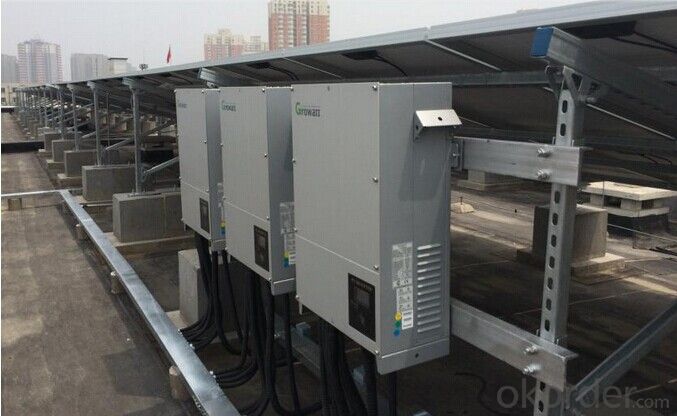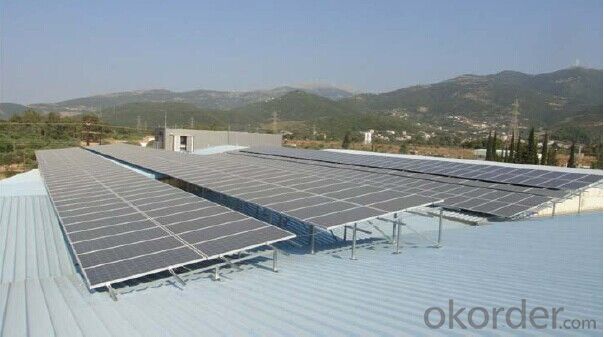Central Grid Connected Solar Inverter CP 250kw
- Loading Port:
- Shekou
- Payment Terms:
- TT or LC
- Min Order Qty:
- 20 pc
- Supply Capability:
- 10000 pc/month
OKorder Service Pledge
OKorder Financial Service
You Might Also Like
Central grid connected Solar inverter CP 250kw
High conversion efficiency of 98.6% deliver more energy
Powerful grid management functions(including LVRT)
Active power continous adjustment adjustment(0-100%)
Reactive power adjustable, PF range 0.9leading-0.9lagging
Friendly touch monitoring interface, easy installation maintenance procedure
Design for max. ROI: newest generation IGBTs and advanced MPPT algorithms
Auxiliary electrical heating(optional)
Comprehensive protection for overvoltage,islanding,short-circuit,overload,overheat etc.
Certificate and approvals including CE,CGC,VDE0126,IEC62109,TUV etc.


Datasheet
| Efficiency | ||||
Max. efficiency | 97.3% | |||
| Output (AC) | ||||
Rated AC output power | 250kVA | |||
| Protection | ||||
DC disconnection device | DC circuit breaker | |||
| General data | ||||
Dimension (W/H/D) | 1600/2080/850 mm | |||
FAQ
1. Have any design tool and how to use it?
Shine Design is the system design software just for inverters,
It can conduct installers to figure out panel numbers for a system, panel numbers for each string,
and which inverter model is suitable for the system.
Moreover, it can print a design report after input all necessary parameters, can calculate DC/AC wire wastage, annual generation, etc.
2. Does the inverter have monitoring solutions for residential system?
For small rating system, we have wired two monitoring solution (ShineNet via RS232 or RS485).
(a) Local wireless monitoring solution (ShineVision via RF module communication)
(b) Global wireless monitoring solution (WIFI module via WIFI network)
3. Do you have free solution for monitoring?
ShineNet is an inverter monitoring software run in Windows XP, Windows Vista, Windows 7 operating system.
It can monitor inverter via RS232 (or RS232 convert to USB cable) and RS485 wire connection.
Customers can purchase the cable locally to get the inverter monitored, it is simple.
- Q:How does a solar inverter handle variations in solar panel cleanliness?
- A solar inverter can handle variations in solar panel cleanliness by continuously monitoring the output power and adjusting the operating parameters accordingly. If the panels are dirty, the inverter will detect a decrease in the output power and adjust the voltage and current to maintain optimal performance. However, if the panels are excessively dirty, it can significantly impact the overall energy production and may require manual cleaning to ensure maximum efficiency.
- Q:What is the role of a solar inverter in grid management and stability?
- Solar inverters have a crucial role to play in the management and stability of the electrical grid when it comes to integrating solar power. They are responsible for converting the direct current electricity produced by solar panels into alternating current electricity that can be used by homes and businesses or fed back into the grid. When it comes to managing the grid, solar inverters are vital for maintaining its stability and reliability. They perform important functions such as voltage regulation, frequency control, and compensating for reactive power. By monitoring the grid conditions and adjusting the solar power output accordingly, inverters help to balance the supply and demand of electricity in real-time, ensuring grid stability. In addition to grid management, solar inverters also contribute to grid stability by improving the quality of power. They actively filter out harmonics, voltage fluctuations, and other electrical disturbances that can be caused by the intermittent nature of solar power generation. This ensures that the electricity generated by solar panels is of high quality and does not introduce any disruptions or damage to the electrical grid. Furthermore, solar inverters enable the seamless integration of solar power into the grid by allowing excess energy to be fed back into the system. This is known as net metering or feed-in tariff programs, which provide compensation for solar energy producers for the surplus electricity they produce. With the help of inverters, the generated solar energy can be efficiently transferred to the grid, reducing the reliance on traditional fossil fuel-based power generation and promoting renewable energy integration. In summary, the role of a solar inverter in grid management and stability is to ensure the smooth integration and optimal utilization of solar power while maintaining the stability, reliability, and quality of the electrical grid. It acts as a bridge between solar energy producers and the grid, facilitating the efficient and sustainable integration of renewable energy sources into the existing power infrastructure.
- Q:How does a solar inverter handle voltage regulation?
- A solar inverter handles voltage regulation by constantly monitoring the voltage from the solar panels and adjusting its output voltage accordingly. It ensures that the voltage produced by the panels matches the required voltage for the electrical grid or the connected devices. This regulation is crucial to maintain stable and reliable power supply, protect the equipment from voltage fluctuations, and ensure optimal energy conversion efficiency.
- Q:The function of photovoltaic grid - connected inverter
- Finally, a sinusoidal AC output for a grid-connected photovoltaic power generation system is generated by a low-pass filter.
- Q:How is the output voltage of a solar inverter regulated?
- The output voltage of a solar inverter is regulated through a combination of voltage control algorithms and power electronics components. These algorithms continuously monitor the voltage level and adjust the inverter's operation accordingly to maintain a stable output voltage. Additionally, power electronics components like DC-DC converters and inverters are used to convert the variable DC voltage generated by the solar panels into a stable AC voltage output that matches the grid requirements.
- Q:Can a solar inverter be installed indoors?
- Yes, a solar inverter can be installed indoors.
- Q:Can a solar inverter be used with electric vehicles?
- Yes, a solar inverter can be used with electric vehicles. Solar inverters are used to convert the DC (direct current) electricity generated from solar panels into AC (alternating current) electricity which can be used to power various devices, including electric vehicles. This allows for the charging of electric vehicles with clean and renewable solar energy.
- Q:What is the maximum AC output current that a solar inverter can provide?
- The maximum AC output current that a solar inverter can provide depends on its rating, which varies depending on the model and capacity of the inverter.
- Q:Can a solar inverter convert DC power to AC power?
- Yes, a solar inverter is specifically designed to convert the direct current (DC) power generated by solar panels into alternating current (AC) power that can be used to power household or commercial electrical appliances and be fed back into the grid.
- Q:How do you choose the right input voltage range for a solar inverter?
- To choose the right input voltage range for a solar inverter, it is essential to consider the specifications and requirements of both the solar panels and the inverter. The input voltage range of the inverter should be compatible with the output voltage range of the solar panels. It is important to ensure that the inverter can handle the maximum voltage generated by the panels during peak sunlight conditions. Additionally, factors such as temperature variations and system losses should also be taken into account while selecting the appropriate input voltage range for a solar inverter.
1. Manufacturer Overview |
|
|---|---|
| Location | |
| Year Established | |
| Annual Output Value | |
| Main Markets | |
| Company Certifications | |
2. Manufacturer Certificates |
|
|---|---|
| a) Certification Name | |
| Range | |
| Reference | |
| Validity Period | |
3. Manufacturer Capability |
|
|---|---|
| a)Trade Capacity | |
| Nearest Port | |
| Export Percentage | |
| No.of Employees in Trade Department | |
| Language Spoken: | |
| b)Factory Information | |
| Factory Size: | |
| No. of Production Lines | |
| Contract Manufacturing | |
| Product Price Range | |
Send your message to us
Central Grid Connected Solar Inverter CP 250kw
- Loading Port:
- Shekou
- Payment Terms:
- TT or LC
- Min Order Qty:
- 20 pc
- Supply Capability:
- 10000 pc/month
OKorder Service Pledge
OKorder Financial Service
Similar products
New products
Hot products
Hot Searches
Related keywords

































